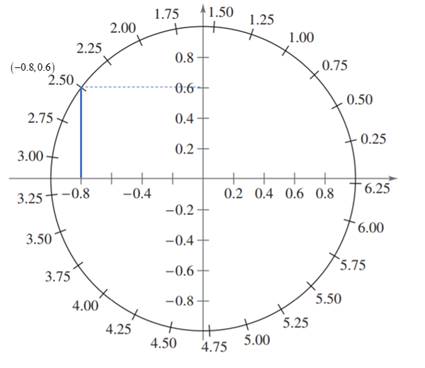
Concept explainers
(a)
To calculate: The value of
(a)
Answer to Problem 72E
The value of
Explanation of Solution
Given information: A figure is provided.
Calculation: Assume that any point on the provided circle of unit length be denoted by where
where 
- Here,
 is the arc length or the angle measured in radians and 3’o clock from the standard position.
is the arc length or the angle measured in radians and 3’o clock from the standard position.
Now, to calculate 
The point that can be pointed on the circle is approximately equal to
Therefore,

The graph using a graphing utility as follows:

The value can be approximated (in radians) using a calculator as,

Hence,
(b)
To calculate: The value of
(b)
Answer to Problem 72E
The value of
Explanation of Solution
Given information: A figure is provided.
Calculation:
Assume that any point on the provided circle of unit length be denoted by where
where 
- Here,
 is the arc length or the angle measured in radians and 3’o clock from the standard position.
is the arc length or the angle measured in radians and 3’o clock from the standard position.
Now, to calculate
The point that can be pointed on the circle is approximately equal to
Therefore,
The graph using a graphing utility as follows:

The value can be approximated (in radians) using a calculator as,
Hence,
Chapter 4 Solutions
PRECALCULUS W/LIMITS:GRAPH.APPROACH(HS)
- Find the derivative of the function. g'(t) = 9t g(t) = In(t) (9ln(t) - 1) [In(t)] 2 × Need Help? Read It Watch Itarrow_forwardFind the accumulated amount A, if the principal P is invested at an interest rate of r per year for t years. (Round your answer to the nearest cent.) P = $3800, r = 4%, t = 10, compounded semiannually A = $ 5645.60 × Need Help? Read It SUBMIT ANSWER [3.33/6.66 Points] DETAILS MY NOTES REVIOUS ANSWERS ASK YOUR TEACHER TANAPCALC10 5.3.001.EP. PRACTICE ANOTHER Consider the following where the principal P is invested at an interest rate of r per year for t years. P = $3,100, r = 4%, t = 10, compounded semiannually Determine m, the number of conversion periods per year. 2 Find the accumulated amount A (in dollars). (Round your answer to the nearest cent.) A = $ 4604.44arrow_forwardForce with 800 N and 400 N are acting on a machine part at 30° and 60°, respectively with a positive x axis, Draw the diagram representing this situationarrow_forward
 Calculus: Early TranscendentalsCalculusISBN:9781285741550Author:James StewartPublisher:Cengage Learning
Calculus: Early TranscendentalsCalculusISBN:9781285741550Author:James StewartPublisher:Cengage Learning Thomas' Calculus (14th Edition)CalculusISBN:9780134438986Author:Joel R. Hass, Christopher E. Heil, Maurice D. WeirPublisher:PEARSON
Thomas' Calculus (14th Edition)CalculusISBN:9780134438986Author:Joel R. Hass, Christopher E. Heil, Maurice D. WeirPublisher:PEARSON Calculus: Early Transcendentals (3rd Edition)CalculusISBN:9780134763644Author:William L. Briggs, Lyle Cochran, Bernard Gillett, Eric SchulzPublisher:PEARSON
Calculus: Early Transcendentals (3rd Edition)CalculusISBN:9780134763644Author:William L. Briggs, Lyle Cochran, Bernard Gillett, Eric SchulzPublisher:PEARSON Calculus: Early TranscendentalsCalculusISBN:9781319050740Author:Jon Rogawski, Colin Adams, Robert FranzosaPublisher:W. H. Freeman
Calculus: Early TranscendentalsCalculusISBN:9781319050740Author:Jon Rogawski, Colin Adams, Robert FranzosaPublisher:W. H. Freeman
 Calculus: Early Transcendental FunctionsCalculusISBN:9781337552516Author:Ron Larson, Bruce H. EdwardsPublisher:Cengage Learning
Calculus: Early Transcendental FunctionsCalculusISBN:9781337552516Author:Ron Larson, Bruce H. EdwardsPublisher:Cengage Learning





